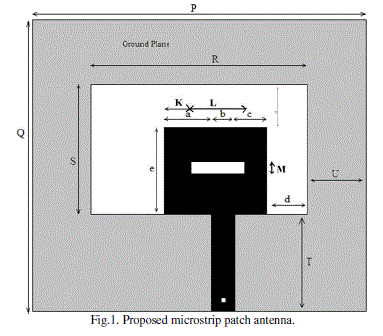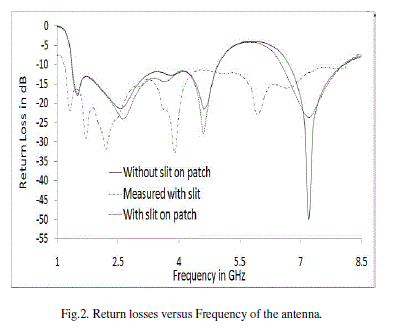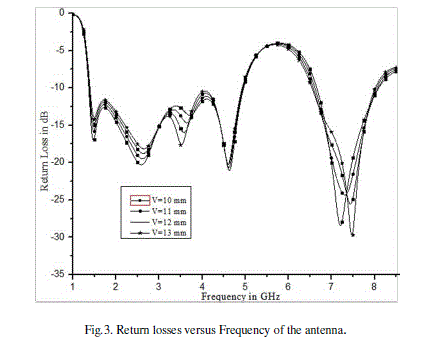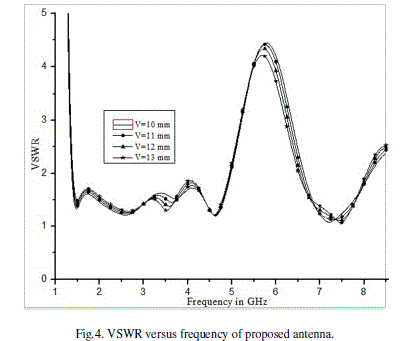ISSN ONLINE(2319-8753)PRINT(2347-6710)
ISSN ONLINE(2319-8753)PRINT(2347-6710)
| Kalyan Mondal 1, Sudipta Paul 2, Priti Rai 3, Deblina Banerjee 4, Manisha Kahar 5. Modern Institute of Engineering and Technology, Bandel, WestBengal, India |
| Related article at Pubmed, Scholar Google |
Visit for more related articles at International Journal of Innovative Research in Science, Engineering and Technology
In this article a broadband microstrip patch antenna is designed with slit incorporated in the rectangular ground plane. The effect of simulated return loss, swept gain and radiation pattern of the proposed antenna have been obtained due to variation of slit dimensions. The proposed antenna is designed by using FR4 substrate with thickness 1.6 mm and dielectric constant 2.4. The proposed antenna is simulated using Ansoft designer software. The results show a large bandwidth, high gain and minimum return loss. The simulated results are in good parity with experimental data. The proposed antenna is very use full for broadband wireless communication systems.
Keywords |
| Microstrip patch, Slits line, Rectangular ground plane, Dielectric constant, Wireless communications, and Ansoft designer |
INTRODUCTION |
| Recent rapidly progress in wireless communication promises to replace wired communication in the near future in which antenna plays a more important role. Microstrip patch antennas are widely used due to their many advantages of low profile, light weight, low cost and broadband [1] etc. The major drawback of microstrip antenna is narrow bandwidth. To overcome this limitation the microstrip patches are to be design with loaded slot or slits like E-Shape [2- 5], U-Shape [6], and Stack patch [7-10]. It is seen that with the increase of bandwidth swept gain of the antenna decreases, but here the gain is moderately high.The proposed microstrip patch antenna is very attractive because of their planar geometry, broadband with high swept gain. The populations in the world are increasing rapidly day by day resulting tremendous applications of the mobile phones. Due to applications of large number of mobile phones at a time, very large bandwidth and multiband is required. Last few years microstrip patch antennas are being investigated to make it more reliable, efficient, compactness and wideband. The proper selection of the slot and slit dimensions, substrate material, dielectric value plays the very important role to increase the bandwidth with high gain. The narrow bandwidth also may be enhanced by increasing the substrate thickness. But however this arrangement increases the antenna area which will decrease the antenna compactness and efficiency. In this paper a microstrip patch antenna is designed with rectangular ground structure with slit loaded on the ground plane to both enhance the performance and reduce the dimension. The proposed antenna provides very good result such as high gain, large bandwidth, and minimum return loss and better compactness. |
ANTENNA DESIGN |
| The design of proposed antenna The design of the proposed antenna is shown in Figure 1.The design microstrip antenna consists of a patch and modified rectangular ground plane which is designed using dielectric constant 2.4 with 1.6 mm thick PTFE substrate. All the dimensions of proposed antenna are given in Table 1. |
 |
ANRENNA RESULTS |
| Figure 2 shows the simulated return loss of proposed antenna with slot and without slot and measured return loss of the antenna with slit on the radiating patch. Figure 3 shows the effect of slit on the ground plane. From Figure 3 it is clear that the resonance frequency is not changed significantly if the width of the slit increased slowly towards upward direction with the frequency and other parameters remain constant whereas the bandwidth is changed significantly from broadband to multiband of the microstrip patch antenna. The effect on VSWR, return loss and swept gain are not changed significantly but the current distribution of the proposed antenna is changed significantly due to variation of the slit dimension. The VSWR, swept gain and current distribution are shown in Figure 4, Figure 5 and Figure 6 respectively. From the obtained results we have seen that the measured data of proposed antenna almost follow the simulated one. The measured bandwidth is significantly enhanced from simulated one. The simulated and measured bands are 3.65 GHz and 6.9 GHz resulting in percentage bandwidth of 114% and 148% respectively. |
 |
 |
 |
CONCLUSION |
| The compact microstrip has been designed using Ansoft designer. The simulated results show that the return loss, VSWR, swept gain due to variation of slits dimension. Measured results have been obtained using standard microwave test bench. This antenna may be used for radar and wireless communications system. It has been observed that the proposed antenna exhibits maximum bandwidth 148%. It has covered multi frequency band from 1.34 GHz to 8.1 GHz. The maximum gain 3.2dBi is achieved at the resonant frequency of 4.58 GHz. |
References |
|